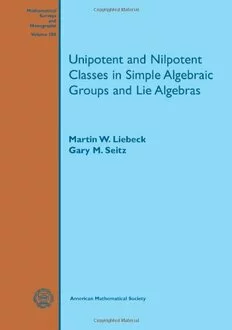Table Of ContentMathematical
Surveys
and
Monographs
Volume 180
Unipotent and Nilpotent
Classes in Simple Algebraic
Groups and Lie Algebras
Martin W. Liebeck
Gary M. Seitz
American Mathematical Society
Unipotent and Nilpotent
Classes in Simple Algebraic
Groups and Lie Algebras
Mathematical
Surveys
and
Monographs
Volume 180
Unipotent and Nilpotent
Classes in Simple Algebraic
Groups and Lie Algebras
Martin W. Liebeck
Gary M. Seitz
American Mathematical Society
Providence, Rhode Island
EDITORIAL COMMITTEE
Ralph L. Cohen, Chair Michael A. Singer
Jordan S. Ellenberg Benjamin Sudakov
Michael I. Weinstein
2010 Mathematics Subject Classification. Primary 20G15, 20G40, 20G41,20E45, 20E32,
17B45, 17B08.
For additional informationand updates on this book, visit
www.ams.org/bookpages/surv-180
Library of Congress Cataloging-in-Publication Data
Liebeck,M.W.(MartinW.),1954–
Unipotentandnilpotentclassesinsimplealgebraicgroupsandliealgebras/MartinW.Liebeck,
GaryM.Seitz.
p.cm. —(Mathematicalsurveysandmonographs;v.180)
Includesbibliographicalreferencesandindex.
ISBN978-0-8218-6920-8(alk.paper)
1.Linearalgebraicgroups. 2.Liealgebras. I.Seitz,GaryM.,1943– II.Title.
QA179.L54 2012
512(cid:2).482—dc23
2011043518
Copying and reprinting. Individual readers of this publication, and nonprofit libraries
actingforthem,arepermittedtomakefairuseofthematerial,suchastocopyachapterforuse
in teaching or research. Permission is granted to quote brief passages from this publication in
reviews,providedthecustomaryacknowledgmentofthesourceisgiven.
Republication,systematiccopying,ormultiplereproductionofanymaterialinthispublication
is permitted only under license from the American Mathematical Society. Requests for such
permissionshouldbeaddressedtotheAcquisitionsDepartment,AmericanMathematicalSociety,
201 Charles Street, Providence, Rhode Island 02904-2294 USA. Requests can also be made by
[email protected].
(cid:2)c 2012bytheAmericanMathematicalSociety. Allrightsreserved.
TheAmericanMathematicalSocietyretainsallrights
exceptthosegrantedtotheUnitedStatesGovernment.
PrintedintheUnitedStatesofAmerica.
(cid:2)∞ Thepaperusedinthisbookisacid-freeandfallswithintheguidelines
establishedtoensurepermanenceanddurability.
VisittheAMShomepageathttp://www.ams.org/
10987654321 171615141312
For Ann and Sheila
Contents
Preface xi
Chapter 1. Introduction 1
Chapter 2. Preliminaries 9
2.1. Notation 9
2.2. Subgroups 13
2.3. Automorphisms and Lie algebras 15
2.4. Frobenius morphisms and the Lang-Steinberg theorem 19
2.5. Nilpotent and unipotent elements 20
2.6. Distinguished parabolic subgroups 24
2.7. Centralizers of nilpotent elements 28
2.8. Distinguished elements in characteristic zero 34
Chapter 3. Classical groups in good characteristic 39
3.1. Preliminary lemmas 40
3.2. Proof of Theorem 3.1 43
3.3. Additional information 49
Chapter 4. Classical groups in bad characteristic: statement of results 59
Chapter 5. Nilpotent elements: the symplectic and orthogonal cases, p=2 65
5.1. Indecomposables 65
5.2. Distinguished nilpotent elements 67
5.3. Distinguished normal form 69
5.4. Centralizers of nilpotent elements I: connected centralizers 71
5.5. Centralizers of nilpotent elements II: component groups 78
5.6. Orthogonal groups of odd dimension 86
5.7. Splitting 89
5.8. Labellings of some nilpotent classes 90
Chapter 6. Unipotent elements in symplectic and orthogonal groups, p=2 91
6.1. Indecomposables 91
6.2. Distinguished unipotent elements 92
6.3. A map from unipotents to nilpotents in SO(V) 93
6.4. A lemma on representations 94
6.5. Centralizers of unipotents I: connected centralizers 96
6.6. Centralizers of unipotents II: component groups 101
6.7. Splitting 109
6.8. Orthogonal groups of odd dimension 110
6.9. Labellings of some unipotent classes 110
vii
viii CONTENTS
Chapter 7. Finite classical groups 113
7.1. Good characteristic 113
7.2. Bad characteristic 116
Chapter 8. Tables of examples in low dimensions 119
Chapter 9. Exceptional groups: statement of results for nilpotent elements 129
Chapter 10. Parabolic subgroups and labellings 133
10.1. T-labellings and associated parabolic subgroups 133
10.2. Labellings of some distinguished classes in classical groups 136
Chapter 11. Reductive subgroups 139
Chapter 12. Annihilator spaces of nilpotent elements 153
12.1. Lemmas on representation theory 153
12.2. Annihilator spaces of distinguished nilpotent elements 156
12.3. Further results 165
Chapter 13. Standard distinguished nilpotent elements 169
13.1. Distinguished nilpotent elements corresponding to distinguished
parabolic subgroups 169
13.2. Component groups 181
13.3. Subgroups J,R 201
Chapter 14. Exceptional distinguished nilpotent elements 203
Chapter 15. Nilpotent classes and centralizers in E 219
8
15.1. Preliminary lemmas 220
15.2. Proof of Theorem 15.1, I: strategy 225
15.3. Proof of Theorem 15.1, II: calculation of the centralizers 228
15.4. Proof of Theorem 15.1, III: completeness of the list 258
Chapter 16. Nilpotent elements in the other exceptional types 263
16.1. The cases where (G ,p)=(cid:54) (F ,2) or (G ,3) 263
0 4 2
16.2. The case (G ,p)=(G ,3) 267
0 2
16.3. The case (G ,p)=(F ,2) 268
0 4
16.4. Dual pairs 276
Chapter 17. Exceptional groups: statement of results for unipotent elements 281
Chapter 18. Corresponding unipotent and nilpotent elements 287
Chapter 19. Distinguished unipotent elements 299
19.1. The proof of Theorem 19.1 301
19.2. The proof of Theorem 19.2 310
Chapter 20. Non-distinguished unipotent classes 317
20.1. The case G=E ,E ,E 317
6 7 8
20.2. The case G=F , p(cid:54)=2 329
4
20.3. The case G=F , p=2 330
4
20.4. The case G=G 332
2
20.5. Proofs of the results 17.1 - 17.10 332
CONTENTS ix
Chapter 21. Proofs of Theorems 1, 2 and Corollaries 3 - 8 341
Chapter 22. Tables of nilpotent and unipotent classes in the exceptional
groups 351
22.1. Classes and centralizers in exceptional algebraic groups 351
22.2. Unipotent classes and centralizers in finite exceptional groups 351
22.3. The dual pairs J,R 352
Bibliography 373
Glossary of symbols 377
Index 379

